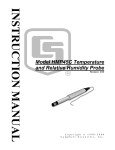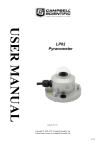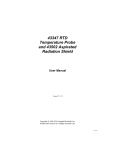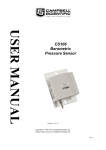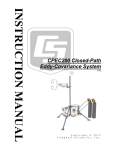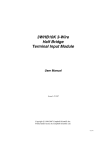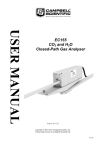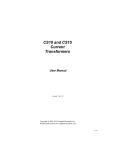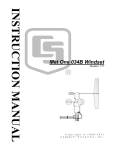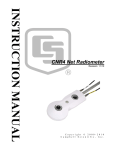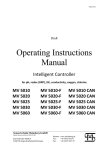Download KH20 Krypton Hygrometer
Transcript
KH20 Krypton Hygrometer User Manual Issued 23.3.10 Copyright © 2010 Campbell Scientific Inc. Printed under Licence by Campbell Scientific Ltd. . CSL 876 Guarantee This equipment is guaranteed against defects in materials and workmanship. This guarantee applies for twelve months from date of delivery. We will repair or replace products which prove to be defective during the guarantee period provided they are returned to us prepaid. The guarantee will not apply to: • Equipment which has been modified or altered in any way without the written permission of Campbell Scientific • Batteries • Any product which has been subjected to misuse, neglect, acts of God or damage in transit. Campbell Scientific will return guaranteed equipment by surface carrier prepaid. Campbell Scientific will not reimburse the claimant for costs incurred in removing and/or reinstalling equipment. This guarantee and the Company’s obligation thereunder is in lieu of all other guarantees, expressed or implied, including those of suitability and fitness for a particular purpose. Campbell Scientific is not liable for consequential damage. Please inform us before returning equipment and obtain a Repair Reference Number whether the repair is under guarantee or not. Please state the faults as clearly as possible, and if the product is out of the guarantee period it should be accompanied by a purchase order. Quotations for repairs can be given on request. When returning equipment, the Repair Reference Number must be clearly marked on the outside of the package. Note that goods sent air freight are subject to Customs clearance fees which Campbell Scientific will charge to customers. In many cases, these charges are greater than the cost of the repair. Campbell Scientific Ltd, Campbell Park, 80 Hathern Road, Shepshed, Loughborough, LE12 9GX, UK Tel: +44 (0) 1509 601141 Fax: +44 (0) 1509 601091 Email: [email protected] www.campbellsci.co.uk PLEASE READ FIRST About this manual Please note that this manual was originally produced by Campbell Scientific Inc. primarily for the North American market. Some spellings, weights and measures may reflect this origin. Some useful conversion factors: Area: 1 in2 (square inch) = 645 mm2 Length: 1 in. (inch) = 25.4 mm 1 ft (foot) = 304.8 mm 1 yard = 0.914 m 1 mile = 1.609 km Mass: 1 oz. (ounce) = 28.35 g 1 lb (pound weight) = 0.454 kg Pressure: 1 psi (lb/in2) = 68.95 mb Volume: 1 UK pint = 568.3 ml 1 UK gallon = 4.546 litres 1 US gallon = 3.785 litres In addition, while most of the information in the manual is correct for all countries, certain information is specific to the North American market and so may not be applicable to European users. Differences include the U.S standard external power supply details where some information (for example the AC transformer input voltage) will not be applicable for British/European use. Please note, however, that when a power supply adapter is ordered it will be suitable for use in your country. Reference to some radio transmitters, digital cell phones and aerials may also not be applicable according to your locality. Some brackets, shields and enclosure options, including wiring, are not sold as standard items in the European market; in some cases alternatives are offered. Details of the alternatives will be covered in separate manuals. Part numbers prefixed with a “#” symbol are special order parts for use with non-EU variants or for special installations. Please quote the full part number with the # when ordering. Recycling information At the end of this product’s life it should not be put in commercial or domestic refuse but sent for recycling. Any batteries contained within the product or used during the products life should be removed from the product and also be sent to an appropriate recycling facility. Campbell Scientific Ltd can advise on the recycling of the equipment and in some cases arrange collection and the correct disposal of it, although charges may apply for some items or territories. For further advice or support, please contact Campbell Scientific Ltd, or your local agent. Campbell Scientific Ltd, Campbell Park, 80 Hathern Road, Shepshed, Loughborough, LE12 9GX, UK Tel: +44 (0) 1509 601141 Fax: +44 (0) 1509 601091 Email: [email protected] www.campbellsci.co.uk Contents PDF viewers note: These page numbers refer to the printed version of this document. Use the Adobe Acrobat® bookmarks tab for links to specific sections. 1. General Description..................................................... 1 2. Specifications .............................................................. 1 2.1 Measurements .......................................................................................... 1 2.2 Electrical .................................................................................................. 1 2.3 Physical .................................................................................................... 2 3. Installation .................................................................... 2 3.1 Siting ........................................................................................................ 2 3.2 Mounting .................................................................................................. 2 3.2.1 Parts and Tools Needed for Mounting ........................................... 2 3.2.2 Mounting the KH20 Sensor............................................................ 2 3.2.3 Mounting the Electronics Box ........................................................ 3 4. Wiring ........................................................................... 5 5. Datalogger Programming............................................ 6 5.1 KH20 Calibration ..................................................................................... 6 5.2 Example 1, CR3000 Program to Measure Water Vapour Fluctuations ... 7 6. Maintenance and Calibration ...................................... 8 6.1 6.2 6.3 6.4 6.5 6.6 Visual Inspection...................................................................................... 9 Testing the Source Tube .......................................................................... 9 Testing the Detector Tube ........................................................................ 9 Managing the Scaling of KH20................................................................ 9 Older KH20 ............................................................................................ 10 Calibration .............................................................................................. 10 Appendix A. Calibrating KH20 ..................................................... A-1 A.1 Basic Measurement Theory ................................................................. A-1 A.2 Calibration of KH20 ............................................................................ A-1 Figures 1. Mounting KH20 onto a tripod .................................................................... 3 2. Proper mounting position of the electronics box ....................................... 4 3. Attaching cables to the electronics box ...................................................... 5 A-1. KH20 ln(mV) vs. Vapour Density ..................................................... A-2 i Tables 1. Datalogger Connections for Differential Measurement ............................. 5 2. KH20 Calibration Ranges .......................................................................... 6 A-1. Linear Regression Results for KH20 ln(mV) vs. Vapour Density ..... A-2 A-2. Final Calibration Values for KH20 .................................................... A-3 ii KH20 Krypton Hygrometer 1. General Description The KH20 is a krypton hygrometer for measuring water vapour fluctuations in the air. The name KH20 (KH-twenty) was derived from KH2O (K-H2O), and the sensor has been known with this name since 1985. It is typically used with the CSAT3 3-D sonic anemometer for measuring latent heat flux (LE), using Eddy Covariance technique. Please refer to the Open Path Eddy Covariance System operator’s manual for details on flux measurements using the KH20 sensor. The KH20 sensor uses a krypton lamp that emits two absorption lines: major line at 123.58 nm and minor line at 116.49 nm. Both of these lines are absorbed by water vapour, and a small amount of the minor line is absorbed by oxygen. The KH20 is not suitable for absolute water vapour concentration measurements due to its signal offset drift. The KH20 heads are sealed and will not suffer damage should they get wet. In addition, the electronics box and the connectors are housed inside a rain shield (#14113) that protects them from moisture. The KH20 is suitable for long-term continuous outdoor applications. The KH20 sensor is comprised of two main parts: the sensor head and the electronics box. The sensor head comes with cables with 6 ft of lead length that connect the sensor to the electronics box. It is shipped with a rain shield (#14113) to protect the electronics box and the connectors from moisture, a 20 inch 3/4 IPS threaded aluminium pipe (#3874), a 3/4” x 3/4” Nu-Rail (#1017), and a 5/32 inch Allen wrench (#4697) for mounting. The sensor comes with a signal/power cable which has 25 ft lead length. If a longer cable is desired, the customer can order a replacement cable (# KH20CBL-L) and specify the desired lead length after -L. NOTE Discussion on the principles and theory of measurement is included in Appendix A. 2. Specifications 2.1 Measurements Calibration Range: Frequency Response: Operating Temperature Range: 1.7 to 19.5 g/m3 (nominal) 100 Hz -30 to +50°C Supply Voltage: Current Consumption: Power Consumption: Output Signal Range: 10 V to 16 Vdc 20 mA max at 12 Vdc 0.24 Watts 0 to 5Vdc 2.2 Electrical 1 KH20 Krypton Hygrometer 2.3 Physical Dimensions Sensor Head: 29 cm x 23 cm x 3 cm (11.5” x 9” x 1.25”) Electronics Box: 19 cm x 13 cm x 5 cm (7.5” x 5” x 2”) Rain Shield with Mount: 29 cm x 18 cm x 6.5 cm (11.5” x 7” x 2.5”) Mounting Pipe: 50 cm (20”) Carrying Case: 64 cm x 38 cm x 18 cm (25” x 15” x 7”) Weight Sensor Head: 31.61 kg (.55 lbs) Electronics Box: 6.4 kg (1.4 lbs) Rain Shield with Mount: 2.2 kg (4.75 lbs) Mounting Pipe with Nu-rail: 0.45 kg) (1.0 lbs) Carrying Case: 4.3 kg (9.45 lbs) Shipping: 9.2 kg (20.15 lbs) Package Includes: KH20 sensor head with 5’ of cables Power/Signal cable with 25’ lead length (#KH20CBL-L) Electronics Box Rain Shield (#14113) Horizontal Mounting Boom (20 inch 3/4” IPS threaded aluminium pipe) (#3874) Nu-rail (3/4” x 3/4”) (#1017) Allen Wrench (5/32”) (#4697) 3. Installation 3.1 Siting When installing the KH20 sensor for latent heat flux measurement in an eddy covariance application, proper siting, sensor height, sensor orientation and fetch are important. Please refer to Section 2 Installation and Mounting of the Open Path Eddy Covariance System manual for more discussion on siting. 3.2 Mounting 3.2.1 Parts and Tools Needed for Mounting You will need the following hardware to mount the KH20 sensor: 1. Tripod (CSI model CM115 standard) or tower 2. CM20x series crossarm (CSI model CM204 standard) 3. 3/4 inch IPS Aluminium Pipe, 12 inches long (#18048) 4. 3/4” x 1” Nu-rail (#1049) 5. Small Phillips and flat-head screw-drivers 6. 1/2 inch wrench 3.2.2 Mounting the KH20 Sensor Mount the KH20 sensor head as follows: 1. 2 Attach the 20 inch long mounting boom to the KH20. User Manual 2. Mount a crossarm onto a tripod or tower. 3. Mount the 12 inch long pipe (#18048) to a crossarm via 1” x 3/4” Nu-rail (#1049). 4. Mount the KH20 onto the 12” long pipe using a 3/4” x 3/4” Nu-rail (#1017). Mount the KH20 such that the source tube, the longer of the two tubes, is positioned on top, as shown in Figure 1. Gather any loose cables and tie them up, using cable ties, onto the tripod or tower mast. Figure 1. Mounting KH20 onto a tripod. 3.2.3 Mounting the Electronics Box Mount the electronics box as follows: 1. NOTE First, remove the front cover of the rain shield by loosening the two pan-head screws on the bottom front of the rain shield, and then pushing the cover all the way up, and sliding it out. It will be difficult to mount the rain shield to a mast with the front cover on, since the 1/2 inch nut holding the bottom U-bolt is located inside the rain shield. 2. Before mounting the rain shield onto a tripod, first mount the electronics box inside the rain shield. Remove the four pan-head screws from the back panel of the rain shield. Align the electronics box, and use the four pan-head screws to secure the electronics box onto the back panel. Make sure the electronics box is pushed all the way up, and the screws are positioned at the bottom of the mounting slot on the electronics box (see Figure 2). This will provide enough room to attach the connectors to the bottom of the electronics box later on. 3 KH20 Krypton Hygrometer Figure 2. Proper mounting position of the electronics box. NOTE If the electronics box is not pushed all the way up during mounting, you will not have enough room to attach the connectors to the bottom of the electronics box, as the U-bolt for the rain shield will block the position of the connectors. 3. 4 Mount the rain shield onto the tripod or tower mast using the U-bolt provided. Make sure that the distance between the KH20 sensor head and the rain shield is within 5 feet so that the cables from the sensor head will be within reach of the electronics box. Also make sure that the rain shield is mounted vertically with an opening pointing downward so that the rain will effectively run down the rain shield and not penetrate inside. User Manual 4. Connect the three cables to the bottom of the electronics box around the Ubolt on the rain shield (see Figure 3). If there is not enough room for the connectors around the U-bolt, make sure the electronics box is mounted at a highest possible position (see step 2). Figure 3. Attaching cables to the electronics box. 5. Place the front cover back on the rain shield and tighten the two pan-head screws to secure it in place. 6. Gather any loose cables and tie them up, using cable ties, onto the tripod or tower mast. 4. Wiring The KH20 sensor is shipped with a power/signal cable with a 25 ft standard lead length. Table 1 shows the connections for the KH20 to the CR1000, CR3000, and CR5000. Table 1. Datalogger Connections for Differential Measurement Function Wire Colour CR1000/CR3000/CR5000 KH20 Signal + White Differential Input (H) KH20 Signal - *Black Differential Input (L) KH20 Power + Red 12V KH20 Power - Black (from Red/Black set) G *Jumper to Shield with user supplied wire Clear 5 KH20 Krypton Hygrometer 5. Datalogger Programming The KH20 sensor outputs 0 to 5 Vdc analogue signal. These signals can be measured using the VoltDiff instruction on the CRBasic dataloggers or the Volt (Diff) (P2) instruction on the traditional Edlog dataloggers. 5.1 KH20 Calibration Each KH20 is calibrated over a vapour range of approximately 2 to 19 g/m3. The calibration is performed twice under the following two conditions: window clean, and scaled. The water vapour absorption coefficient for three different vapour ranges are calculated from the collected calibration data: full range, dry range, and wet range. Table 2 shows a sample of the KH20 vapour ranges over which three different water vapour absorption coefficients are calculated. See Appendix A for more information on KH20 calibration. Table 2. KH20 Calibration Ranges Ranges Vapour Density (g/m3) Full Vapour Range 2 – 19 Dry Vapour Range 2 – 9.5 Wet Vapour Range 8.25 – 19 Before the water vapour absorption coefficient, kw, is entered into the datalogger program for the KH20, the following decisions must be made: • Will the windows be allowed to scale? • What vapour range is appropriate for the site? Once the decision is made, the appropriate kw can be chosen from the calibrations sheet. The calibration sheet also contains the path length, x, for a specific KH20. Using the water vapour absorption coefficient for either the dry or the wet vapour range will produce more accurate measurements than using that for the full range. If the vapour range of the site is unknown, or if the vapour range is on the border line between the dry and the wet vapour ranges, the full range should be used. 6 User Manual 5.2 Example 1, CR3000 Program to Measure Water Vapour Fluctuations The following example program measures the KH20 at 10Hz, and stores the average values into a data table called ‘stats’, as well as the raw data into a data table called ‘ts_data’. NOTE The KH20 cannot be used for measuring absolute water vapour concentration. 'CR3000 Series Datalogger 'This datalogger program measures KH20 Krypton Hygrometer. 'The station operator must enter the constant and the calibration value for the KH20. 'Search for the text string "unique" to find the locations of these constants 'and enter the appropriate values found from the calibration sheet of the KH20. '*** Unit Definitions *** 'Units 'ln_mV 'mV ‘rho_w Units ln(mV) (natural log of the KH20 millivolts) millivolts g/m^3 '*** Wiring *** 'ANALOG INPUT '1H KH20 signal+ (white) '1L KH20 signal- (black) 'gnd KH20 shield (clear) 'EXTERNAL POWER SUPPLY 'POS KH20 power+ (red) ' datalogger POWER IN 12 (red) 'NEG KH20 power- (black) ' KH20 power shield (clear) ' datalogger POWER IN G (black) PipeLineMode '*** Constants *** 'Measurement Rate Const SCAN_INTERVAL = 100 '10 Hz '100 mSec 'Output period Const OUTPUT_INTERVAL = 30 Const x = 1 Const kw = -0.150 Const xkw = x*kw 'Online flux data output interval in minutes. 'Unique path length of the KH20 [cm]. 'Unique water vapour absorption coefficient [m^3 / (g cm)]. 'Path length times water vapour absorption coefficient [m^3 / g]. '*** Variables *** Public panel_temp Public batt_volt Public kh(2) 7 KH20 Krypton Hygrometer Public rho_w Alias kh(1) = kh_mV Alias kh (2) = ln_kh Units panel_temp = deg_C Units batt_volt = volts Units kh_mV = mV Units ln_kh = ln_mV Units rho_w = g/m^3 '*** Data Output Tables *** 'Processed data DataTable (stats,True,-1) DataInterval (0,OUTPUT_INTERVAL,Min,10) Minimum (1,batt_volt,FP2,False,False) Average (1,panel_temp,FP2,False) Average (2,kh(1),IEEE4,False) EndTable 'Raw time-series data. DataTable (ts_data,True,-1) DataInterval (0,SCAN_INTERVAL,mSec,100) Sample (1,kh_mV,IEEE4) EndTable '*** Program *** BeginProg Scan (SCAN_INTERVAL,mSec,3,0) 'datalogger panel temperature. PanelTemp (panel_temp,250) 'Measure battery voltage. Battery (batt_volt) 'Measure KH20. VoltDiff (kh_mV,1,mV5000,1,TRUE,200,250,1,0) ln_kh = LOG(kh_mV) rho_w = ln_kh/xkw CallTable stats CallTable ts_data NextScan EndProg 6. Maintenance and Calibration The KH20 sensor is designed for continuous field application and requires little maintenance. The tube ends for the KH20 have been sealed with silicone elastomer using an injection-mould method. Therefore, the tubes are protected from water damage, and the KH20 continues to make measurements under rainy or wet conditions. If the water tends to pool up on the tube window and blocks the signal, you can turn the sensor head at an angle so as to shed the water off the tube window. The rain shield protects the electronics box and the connectors from moisture. 8 User Manual 6.1 Visual Inspection • Make sure the optical windows are clean. • Inspect the cables and connectors for any damage or corrosion. If you see a discoloration on the white co-axial cable, you may suspect that the cable has water damage. 6.2 Testing the Source Tube The source tube is the longer of the two tubes. You can check to see if the source tube is working properly by performing the test explained below. First, make sure the UV light is emitted from the source tube. To do this, you may look into the source tube (the longer of the two tubes), and you should see a bright blue light emitted from it. NOTE Avoid looking into the source tube for an extended period of time when the KH20 is powered on to minimize the prolonged exposure to the UV light. If you see a faint or flickering blue light, perform the following test. Check the current drain on the KH20 Typical current drain for the KH20 during normal operation should be 15 ~ 20 mA. The current drain of around 5 mA or less indicates the problem on the source tube. Obtain an RMA from Campbell Scientific, Inc. and send the unit in for repair. Check the voltage signal output from the KH20 If the voltage output reading is below 50 mV, you may have problems with either the source tube or the detector tube. For the detector tube testing, see Section 6.3 below. 6.3 Testing the Detector Tube If the source tube tests fine but the output from KH20 is still in question, perform the following test. Prepare a piece of paper and insert it between the source tube and the detector tube to completely block the optical path. You should see an immediate decrease in the voltage reading, and it should go close to zero. No noticeable change in the voltage output, when the optical path is completely blocked, indicates a problem in the detector tube. If the decrease in the voltage reading takes place but the reading remains below 50 mV, when the paper is removed from the optical path, the source tube may be at fault. Obtain an RMA from Campbell Scientific, Inc. and send the unit in for repair. 6.4 Managing the Scaling of KH20 The KH20 cannot be used to measure an absolute concentration of water vapour, because of scaling on the source tube windows caused by disassociation of atmospheric continuants by the ultra violet photons (Campbell and Tanner, 1985 and Buck, 1976). The rate of scaling is a function of the atmospheric humidity. In a high humidity environment, scaling can occur within a few hours. That scaling attenuates the signal and can cause shifts in the calibration curve. 9 KH20 Krypton Hygrometer However, the scaling over a typical flux averaging period is small. Thus, water vapour fluctuation measurements can still be made with the hygrometer. To see if the source tube window has been scaled, get a clean, dry cotton swab and slide it across the source tube window. The scale is not visible to the naked eye, but if the window is scaled, you will feel a slight but noticeable resistance while you slide the swab across the window. There will be little resistance if the window is not scaled. If you determine the window is scaled, you can clean it with a wet cotton swab. Use distilled water and a clean cotton swab to clean the scaled window. After cleaning the window, slide a clean, dry swab across the window to confirm the scale has been removed. NOTE You can use the water vapour absorption coefficient for scaled window from the calibration sheet if the window will be allowed to scale during measurements. 6.5 Older KH20 The older version of the KH20 used to suffer permanent damage when exposed to water, due to corrosion and loss of vacuum within the tubes. The new version of the KH20 has employed a new sealing around the window to prevent this type of damage. 6.6 Calibration For quality assurance of the measured data, Campbell Scientific, Inc. recommends the KH20 be recalibrated every two years. Please contact Campbell Scientific, Inc. to obtain an RMA number for recalibration. For more information on the calibration process, refer to Appendix A of this manual. 10 Appendix A. Calibrating KH20 A.1 Basic Measurement Theory The KH20 uses an empirical relationship between the absorption of the light and the material through which the light travels. This relationship is known as the Beer’s law, the Beer-Lambert law, or the Lambert-Beer law. According to the Beer’s law, the log of the transmissivity is anti-proportional to the product of the absorption coefficient of the material, k, the distance the light travels, x, and the density of the absorbing material, ρ. The KH20 sensor uses the UV light emitted by the krypton lamp: major line at 123.58 nm and the minor line at 116.49. As the light travels through the air, both the major line and the minor line are absorbed by the water vapour present in the light path. This relationship can be rewritten as follows, where kw is the absorption coefficient for water vapour, x is the path length for the KH20 sensor, and ρw is the water vapour density. T = e − k w xρ w A-1 If we express the transmissivity, T, in terms of the light intensity before and after passing through the material as measured by the KH20 sensor, V and V0, respectively, we obtain the following equation. V = e −kw xρ w V0 A-2 Taking the natural log of both sides, and solving for the density, ρw, yields the following equation. ρw = 1 (lnV − ln V0 ) − kw x A-3 If the path length, x, and the absorption coefficient for water, kw are known, it becomes possible to measure the water vapour density ρw, by measuring the signal output, V, from KH20. A.2 Calibration of KH20 The KH20 calibration process is to find the absorption coefficient of water vapour, kw. To do this, we rewrite the equation A-3, and solve for ln(V). ln V = −k w xρ w + ln V0 A-4 It now becomes obvious from the equation A-4 that there is a linear relationship between the natural log of the KH20 measurement output, lnV, and the water vapour density, ρw. Figure A-1 shows the plot of the equation A-4 after we ran a KH20 over a full calibration vapour range. A-1 KH20 Krypton Hygrometer 8 KH2O Output (mV) 7.5 7 6.5 6 5.5 5 4.5 4 1.74 3.02 4.17 5.44 6.71 7.95 9.2 10.47 11.69 12.9 14.22 15.46 16.78 18.04 19.25 Vapour Density (g/m3) Figure A-1. KH20 ln(mV) vs. Vapour Density We can perform the linear regression on the plot above to obtain the slope for the relationship between the ln(mV) and the vapour density. The slope for the graph above will be the coefficient, kwx which we are after. Table A-1 below shows the result of linear regression analysis. Again the slope is the product of the absorption coefficient of water vapour, kw, and the KH20 path length, x. Table A-1. Linear Regression Results for KH20 ln(mV) vs. Vapour Density Description Values Slope (xkw) -0.205 Y Intercept (ln(V0) 8.033 If we substitute these values, along with the measured lnV into equation A-3, we can obtain the water vapour density, ρw. Campbell Scientific, Inc. performs the calibration twice for each KH20: once with the window cleaned, and again with the window scaled. We then break up the vapour density range into dry and wet ranges, and compute the kw values for each sub range, as well as for the full range. If you know the vapour density range for your site, it is recommended that you select the coefficient, kw, that is appropriate for your site, the dry range or the wet range. If the vapour range for the site is unknown, or if the vapour range is on the border line between the dry and the wet ranges, use the value for the full range. Table A-2 shows the final calibration values the KH20 calibration certificate contains. The data shown in Table A-2 is from an actual KH20. A-2 Appendix A. Calibrating KH20 Table A-2. Final Calibration Values for KH20 Vapour Range (g/m3) Slope (xkw) Y Intercept ln (V0) Coefficient (kw) Full Range 1.74 ~ 19.25 -0.205 3087 -0.144 Dry Range 1.74 ~ 9.20 -0.216 3259 -0.151 Wet Range 7.95 ~ 19.25 -0.201 2899 -0.141 A-3 CAMPBELL SCIENTIFIC COMPANIES Campbell Scientific, Inc. (CSI) 815 West 1800 North Logan, Utah 84321 UNITED STATES www.campbellsci.com • [email protected] Campbell Scientific Africa Pty. Ltd. (CSAf) PO Box 2450 Somerset West 7129 SOUTH AFRICA www.csafrica.co.za • [email protected] Campbell Scientific Australia Pty. Ltd. (CSA) PO Box 444 Thuringowa Central QLD 4812 AUSTRALIA www.campbellsci.com.au • [email protected] Campbell Scientific do Brazil Ltda. (CSB) Rua Luisa Crapsi Orsi, 15 Butantã CEP: 005543-000 São Paulo SP BRAZIL www.campbellsci.com.br • [email protected] Campbell Scientific Canada Corp. (CSC) 11564 - 149th Street NW Edmonton, Alberta T5M 1W7 CANADA www.campbellsci.ca • [email protected] Campbell Scientific Centro Caribe S.A. (CSCC) 300N Cementerio, Edificio Breller Santo Domingo, Heredia 40305 COSTA RICA www.campbellsci.cc • [email protected] Campbell Scientific Ltd. (CSL) Campbell Park 80 Hathern Road Shepshed, Loughborough LE12 9GX UNITED KINGDOM www.campbellsci.co.uk • [email protected] Campbell Scientific Ltd. (France) Miniparc du Verger - Bat. H 1, rue de Terre Neuve - Les Ulis 91967 COURTABOEUF CEDEX FRANCE www.campbellsci.fr • [email protected] Campbell Scientific Spain, S. L. Psg. Font 14, local 8 08013 Barcelona SPAIN www.campbellsci.es • [email protected] Campbell Scientific Ltd. (Germany) Fahrenheitstrasse13, D-28359 Bremen GERMANY www.campbellsci.de • [email protected] Please visit www.campbellsci.com to obtain contact information for your local US or International representative.






















